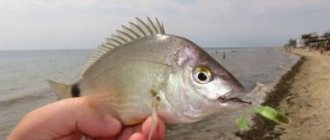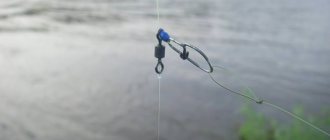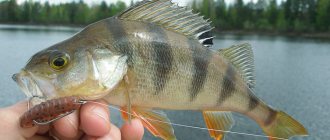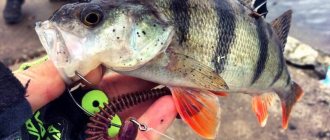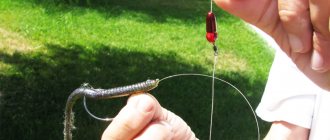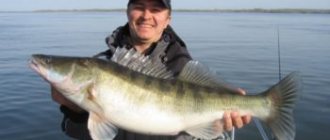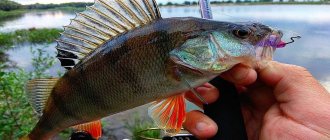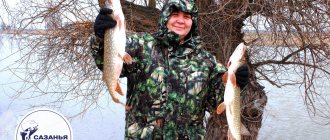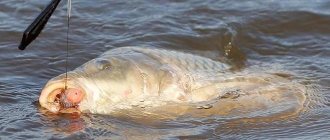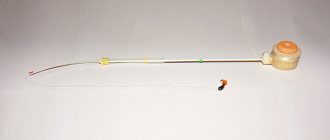When catching predatory fish in many bodies of water, spinning anglers are faced with the problem of frequent bait breaks when sinkers lie between stones at the bottom or get caught on snags.
Until recently, the only “panacea” for losing bait was the use of offset hooks - but the most advanced method used, not only to avoid such situations, but also to increase the catch, was the gradual expansion of fishing on a retractable leash.
Technique of fishing with a spinning rod on a retractable leash
When fishing with artificial baits using this equipment, all its elements are very important - from the configuration of the equipment to the correct execution of casting, retrieving, hooking and retrieving. All this will be discussed in more detail in this article.
Casting
Unlike a classic jig rig, a retractable leash, due to the presence of deflections for attaching the sinker and bait, has a greater tendency to overwhelm.
Therefore, the cast should be performed as follows:
- The cord or fishing line is wound with a reel, minimizing the distance from the tulip (the last ring of the rod blank) to the attachment point for the equipment with the main fishing line;
- Slowly move the rod to the side, visually checking that there are no overlaps or twists;
- Cast with a smooth lateral movement;
Postings
When fishing with spaced rigs, the following fishing techniques are used:
- Slow, steady with small twitches - best attracts perch;
- Standard stepped - most often “catches” pike and pike perch;
- Snatch (twitching) – universal wiring for catching an active predator;
Bite
The predator's grip when using such a rig occurs, as when using a jig rig, during pauses or slowdowns in the movement of the bait.
Sweeping
Since when gripping the bait with this rig, the predator does not feel the weight of the sinker, as would be the case when fishing with a classic jig, the hook is done after a short pause of a few seconds - this allows the fish to take the bait better and thus ensure a more reliable hook of the hook to the fabric graze. Bites from small and medium-sized perch are very often accompanied by self-hooking.
Fishing
The fishing technique as a whole is not much different from the standard one used when jig fishing:
- If there is a small perch, grass pike or small pike perch on the hook of the bait, fishing is carried out by simply winding the line with a reel;
- If a large and quite aggressive predator is hooked, it is caught using the “pumping out” method - the prey is pulled up, moving the rod from the initial horizontal position to one close to vertical, after which it is lowered again, selecting the line with a reel. “Pumping out” is performed until the predator is at a distance sufficient to insert it into the prepared landing net bucket. When fishing in this way, the main thing is not to put the rod far behind your back when lifting and when lowering the rod, quickly reel in the slack in the fishing line.
Mounting options
Spinning fishing on a diverting leash using Moscow equipment is possible in any body of water, regardless of the depth and strength of the current.
And yet, on small rivers and closed lakes, this amazing method has never found widespread use. It is more suitable for a large or medium-sized river, where it can be used to effectively fish for various bottom irregularities located at a considerable distance from the shore. A retractable leash is primarily for running fishing and long casts, although no one forbade fishing with it from a boat either. Installation with a diverting leash shows good results throughout the warm season, from early spring until the first serious frost. It is capable of waking up a predator in the heat, when it is extremely passive and is not at all interested in spinners, wobblers and soft baits on a jig head.
Spinning fishing with a retractable leash is aimed at predatory fish that prefer to stay in the bottom horizons. Typically, perch predominates in the catches, but for targeted hunting for pike perch, pike and asp, this method is also quite applicable. Especially if the fish behaves sluggish and apathetic. Moscow equipment should be in the arsenal of every spinning player just for such a case.
Fishing with a spinning rod is considered one of the most lethal methods of fishing. Especially if you are fishing for bass. The installation is so simple and catchy that it was banned in official competitions. But why shouldn’t ordinary amateur fishermen adopt it in order to more often return from fishing with their heads held high and a good catch?
Let's figure out why it attracts fish so much and how to choose the most successful installation among the many methods and equipment options.
In this picture I have collected for you the most common rigging methods, each of them has its own pros and cons. Some of them will be less tangled, the other will be easier to make from the simplest materials at hand, without even using swivels. It’s better to try several options yourself to see which one is best for you.
An important point regarding the casting technique of this tackle. To make the leash less tangled, you should slow down the cord a little at the end of the flight. On inertial coils, this happened automatically, because. at the end of the flight, the reel is braked with a finger, the leash moves forward by inertia and straightens out, which prevents it from becoming more entangled.
Usually, perch is purposefully caught using the Moscow rig, but pike, pike perch and ide also bite as by-catch. By the way, for the latter, this is a very successful equipment option. Small rotating spoons are exactly what will not leave this predatory representative of cyprinids indifferent.
When fishing for pike, be sure to use a steel or thick fluorocarbon leader. The toothy one loves the movement of the bait in the horizontal plane, so this is a very successful equipment for catching grass. When hunting for larger pike, I prefer classic jig wiring and the use of large vibrating tails.
Small pike perch are also not bad at catching on the “divert line”. But large individuals prefer more expressive vertical, falling movements of the bait, therefore, for hunting for trophy pike perch, the use of a retractable leash seems inappropriate to me.
There are several types of fishing with a retractable leash:
- Feeder. The “helicopter” rig uses a retractable leash.
- Trolling. The diverter mount is effective for fishing at depth and for luring fish out of grass thickets.
- Spinning. A retractable leash is used with a jig-spinning rod.
- Fishing with wiring. For fishing in fast currents and near a rocky bottom with large thickets, a diverter leash is indispensable.
- Winter fishing. In still water, a retractable leash speeds up the fishing process with the help of a weighty sinker. On the current, it is used like a “helicopter” from feeder fishing.
There are three types of installation of a diverter leash:
- deaf;
- complicated;
- sliding.
The first type is the simplest type of installation. A load is attached to the main fishing line, moving upward from it by 20–30 cm, and a loop is tied to which an additional leash with bait will be attached.
For a more complicated type of installation, instead of a loop, you can attach a double swivel, to the free eye of which an additional leash is tied. Using a triple swivel, you can separate the weight, hook and bait into three separate lines. This type of fastener is suitable for fishing in a body of water with a current. Thanks to the swivels, the tackle does not get twisted or tangled, and in case of a snag, you can remove only part of the line without losing the rest of the equipment.
The sliding type is different in that the bait is tied to the main line, and the weight on a separate leash slides freely along it. A leash with a weight 20–30 cm long is attached to a swivel. The main line is passed through the other eye of the swivel. Another swivel, similar in size to the first, is attached to its end. It serves as a stopper for a fishing line with a weight and as a mount for a separate leash with a hook.
Lines with weights and hooks can be swapped. Thus, the leash with the bait will be sliding, which will create certain difficulties. During casting, the weight will move further than the bait. To limit the area over which the sliding leash can move, another swivel is installed on the main line with an indentation of 20–30 cm.
Pike perch is among the largest fish that can be caught in Russia. Its body weight can be about 20 kg, and its length can be more than 1 m. This fish lives in large and medium-sized Eastern European rivers, and can also be found in lakes such as Seliger, Ladoga and Chudskoye. A small number of pike perch are also found in small rivers. Most often, this fish is caught in the Caspian and Azov seas, as well as in the rivers connected to them.
The rig with a diverter lead includes the following elements:
- A spinning rod measuring 2.5–3 m with a medium and fast action. The advantage of such a fishing rod is that it can be suspended, without tension on the fishing line. You can fish with it from a long distance. It is worth choosing a model with the lightest weight, since fishing time can be long, and hand fatigue is not the most pleasant result.
- Coil without inertia, suitable for basic design. It must withstand a weight of 20 kg and be of high quality.
- Fishing line for constructing a leash. In this case, a braided cord is suitable, which can stretch and feel the bait better. The diameter of the chosen fishing line depends on the size of the fish you intend to catch.
- Steel leash. Suitable for its manufacture: monofilament fishing line or metal string. This leash can be used repeatedly by moving it to another line.
- Lead weight. This element is important for completing any equipment. You can also use lighter weights: a Tyrolean stick or a bullet.
- Lures. Typically, flavored silicone models are used.
Installation of equipment for catching pike perch with a retractable leash consists of several stages:
- A fishing line made of braided material measuring 0.12 mm is selected. The carrying capacity of this line is 8 kg, and it is very sensitive to bites.
- The second line is attached to the main leash using a swivel with a clasp or simply wound without additional fastenings.
- Select a sinker weighing 15–30 grams. For long-distance casting, it is better to choose a pear-shaped model.
- The main line is connected to the sinker and bait.
- All fastenings are checked for strength.
Jig is a silicone-based bait. She sinks quickly and stays firmly on the hook.
Twisters impregnated with attractant are a fairly popular bait. It has a natural appearance, large mass and slowly sinks into water. The fish is not afraid of it, mistaking it for living prey.
We suggest you familiarize yourself with: Fly fishing rod equipment - read on Catcher.fish
Floating suspenders and wobblers are similar to twisters, but unlike the latter they have less depth. They are best used for small fish that live near the surface of the water.
Spreaders, Devons, turntables and castmasters are used in rare cases and only with high currents. Heavy loads are used with them.
For pike perch, it is better to use green and orange baits. But these colors only work in clear weather. On cloudy days, you need to choose brighter models: black, brown or blue. The size and shape of the bait depends on the size of the prey.
The technique for placing bait is very important in the fishing process. It can be of two types:
- Uniform bait. This type is usually used by beginners. To ensure uniform rotation of the reel, the rod is placed vertically. With this method of fishing you should not expect a big catch.
- Step option. It is suitable for any type of bait. The spinning rod is cast to the required distance so that a slope appears between the end of the bait and the rod. The reel is then reeled in until the tip of the bait weakens and sinks into the water. This procedure is repeated at short intervals.
Advice for beginners: remember that fishing with a retractable leash is quite difficult. To begin with, you can practice on smaller fish and not strive to hunt predators. The technique needs to be mastered gradually and experience gained. There is no need to overload the equipment; it should, first of all, be convenient and easy to use.
Using too large and bright baits can scare away the fish. Bright elements can only be used in a muddy body of water. All gear should have as natural a look as possible. The selection of all equipment elements depends on the planned catch. The choice of hook depends on the type of bait.
Training may take some time, you need to have some patience and periodically practice catching. It would be a good idea to ask more experienced fishermen for advice.
For a certain time, there was a misconception that a retractable leash was only suitable for perch fishing and was not applicable for predators. But later it turned out that pike are more willing to bite on equipment with a retractable leash than on a regular jig. In addition, this option allows you to fish in hard-to-reach places.
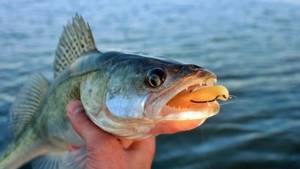
Pike perch on the outlet
Installation (fastening) of the outlet leash
Using a triple swivel (solid mounting)
This equipment option is the simplest and most reliable. It is knitted as follows:
- A piece of monofilament fishing line Ø 0.14-0.18 mm, 30 cm long, with a drop-shaped or stick-shaped sinker at the end is tied to the lower ring of the triple swivel. The weight of the sinker when fishing in still water is 10-12 g, in the current - over 20 g;
- A withdrawal leash made of fishing line Ø 0.14-0.18 mm (for catching perch) or Ø 0.20-0.22 (for catching pike and pike-perch) is tied to the swivel ring located at right angles to the bottom one. The length of the leash is, depending on the fishing conditions, on average 1-1.5 meters;
- A bait attached to an offset or simple hook is tied to the end of the leash;
- The resulting equipment is attached to the main line using the remaining free ring of the triple swivel;
Using a double swivel (sliding rig)
Installation of sliding equipment, in which, unlike the previous one, instead of one triple one, two double swivels are used, is carried out slightly differently than in the case of a blind one:
- A leash with bait is tied to one of the rings of a simple double swivel;
- A small piece of fishing line with a second swivel previously attached to it is tied to the second ring;
- A loop is made at the end of a short piece of fishing line, with which it is attached to the main cord;
- A leash with a sinker is tied to the ring of the second swivel opposite the one through which it is attached to a short piece of fishing line;
Without swivels (simplified version of blind equipment)
This option is most often used when installing it directly on a pond in the absence of swivels.
It is done like this:
- On a segment of fishing line, they retreat 20 cm from one of its ends and make a loop 30 cm long;
- A sinker is attached to the loop with a cape;
- A bait attached to an offset hook is tied to a long branch;
- A small loop is made on the short branch to attach the mount to the main line;
Complicated options
More complex types of leader tackle include Carolina and Texas rigs and drop-shots.
Carolina rig
- A sliding cone-shaped sinker (bullet) is put on the main fishing line or cord, and its narrow part should be facing in the direction of movement of the fishing line;
- After the sinker, a stopper bead is installed;
- A simple swivel is tied to the end of the main line;
- A leash 0.5-0.8 meters long with a bait attached to an offset hook is tied to the swivel;
Texas rig
Similar in components to the previous one.
The difference is that the stopper bead and sinker are placed on the leash with the bait, and not on the main line
Drop shot
- An elongated sinker weighing from 10 to 20-30 grams is tied to a meter-long piece of fishing line.
- An offset hook is placed on the fishing line and fixed on it at a distance of 30-50 cm from the sinker so that it is positioned vertically and its tip is facing upward
- A silicone bait is placed on an offset hook;
- A loop is knitted in the upper part of the rig to attach it to the main fishing line;
Equipment and installation
The branch design is also called “Moscow equipment” and has several types of basic installation in its arsenal.
The equipment is designed in such a way that only the tip of the rod is active, which ensures the greatest ease of biting and the complete absence of heaviness and a suspended sinker. For catching pike perch on a retractable leash, it is optimal to use a hard spinning rod 3 m long, with a dough of 10-30 g, and a reel with a soft stroke. However, these parameters depend quite heavily on the bait and the load used.
The design of the Moscow rig consists of a main fishing line with a weight attached to it, above which a branch leash with bait, 70 - 120 cm long, is attached.
The weight of the load is selected individually for each bait and should be 2-3 times greater to ensure maximum efficiency of the structure.
The shape of the sinker largely depends on the bottom topography; weights in the shape of pins and cones are considered universal.
There are a huge number of modifications for attaching a leash: the most primitive of them involves the “loop to loop” method. This installation does not involve the use of additional equipment, but has a number of significant disadvantages, one of which is the constant twisting of the leash around the main line during casting and even retrieving.
If the leash uses the same cord as the base, tangling will be even more noticeable.
The two main types of how it is installed include sliding and blind mounting options. Sliding installation involves sliding a swivel attached to a cargo leash within the limits provided by the main fishing line (cord), at the end of which the leash and bait are located.
Blind installation provides for the use of a triple swivel. Its lower end should be connected to the leash to which the sinker is attached.
The side end serves as a clamp for the leash and bait. It is also possible to use wire leads that are L-shaped, or a leash to which the bait is attached with a cord above the sinker, without the need to use a swivel.
It will also be effective to tie a load and bait on each end in a situation where a thick fishing line (a meter-long piece of it) is involved. A simple loop is tied and attached to the main cord by fastening it.
Although such equipment will be convenient to store, it will not be prone to excessive tangling, nevertheless, in the event of a dead hook, it will definitely be lost. Delicate fishing with it will not yield results, since in such a situation it will be too rough.
And here's what you need to know: DIY installation of 6 popular feeder equipment || Fishing with a feeder in still water equipment
The outlet leash is used for the following types of equipment:
- Feeder - in the manufacture of helicopter gear.
- Spinning – the most commonly used type of installation is “Moscow rigging”.
- Winter fishing rod - a heavy sinker speeds up the fishing process in reservoirs with standing water.
- Trolling - retraction helps to move the bait over thickets of grass, as well as to fish at great depths.
- Wiring – suitable for fishing with fishing on rivers with fast and strong currents.
Installation of such equipment is quite simple:
- A weight is tied to the end of the fishing line, the weight of which is usually 15-30 grams.
- Above the sinker, at a distance of 25-40 cm (maybe more, depending on the fishing depth), a meter-long leash is attached.
- A suitable bait is tied to the leash.
Elements of tackle with a retractable leash
Spinning
- Length
For coastal fishing, rods with a length of 2.4 to 3.0 meters are suitable, from a boat - 1.8-2.4 meters.
- Build
Blanks with fast and ultra-fast action and a thin and sensitive tip are best suited for fishing with a retractable leash.
- Test
Coil
Shimano size:
- For perch fishing – 2000
- For pike, pike perch – 3000
Gear ratio
For this equipment, the reel must make at least 5 revolutions of the spool per revolution of the handle.
Number of bearings
As with those used in jigging, for reels used in fishing with a retractable leash, it is necessary to have at least 5 reliable bearings, of which 1 must be in the line roller
Main line
Material:
For catching small and medium-sized perch and short casting distances, use monofilament fishing line. If the main purpose of fishing is larger predators - pike, pike perch - use a braided cord
Section:
- For monofilament – 0.22-0.25 mm.
- For braided cord – 0.1-0.16 mm.
Leash
Section:
- Perch – 0.14-0.18 mm.
- Pike and pike perch - 0.2.0 - 0.22 mm
- Color – transparent, less often black or another color to match the water
Material:
Most often, monofilament or stronger fluorocarbon fishing line is used for a leash.
Rubber
The following are used as baits:
- Twisters
- Vibrotails
- Foam rubber fish
- Less commonly, but small wobblers and spinners are used
The bait tied to the outlet leash should have a length of no more than 5-7 cm.
Hook
When fishing with a retractable leash, use both a simple and an offset hook. At the same time, offset machines are more common when conducting work in places with a large amount of grass, snags, and various debris
The size and shape of the hook is selected taking into account the size of the bait
Snap Options
Layout
The tackle consists of two leashes, attached at one point to the main fishing line. The classic layout is considered to be one in which the lead with the bait is about a meter long, and the lead of the sinker is 30 centimeters.
However, these parameters can be changed depending on the fishing conditions, keeping in mind that long rigs will require the use of a longer spinning rod and fishing skill when casting.
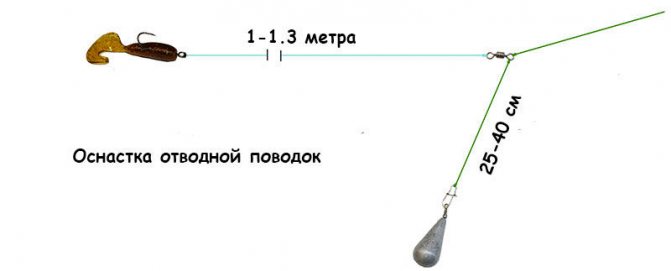
Classic rig options
Types of sinkers for a withdrawal leash
Bullet
It is a cone-shaped sinker used in Texas and Carolina rigs.
Drop shot
Extended weights that pass snags and stones well with a special clamp that allows it to be securely fixed on the fishing line and moved along it if necessary
Tyrolean stick
It is an elongated plastic cylinder (stick) with a fastener at the top and a lead plug at the bottom. Due to its shape and the presence of air inside, such a sinker allows you to carry equipment through the most snaggy and cluttered places
Long
Long is a special, teardrop-shaped sinker with rounded upper and lower surfaces. Most often it is used in a drop shot rig.
Baits and lures for the outlet leash
Lure color and size
For fishing with a retractable leash, silicone baits made of edible and inedible rubber are most often used.
The color and size of the bait depends on the type of predator for which the gear is designed, currents, depth and weather conditions.
Perch
When catching perch, a fish that does not differ in trophy size, small twisters up to 3 cm long, yellow or lemon in color, are used.
Zander
The fanged predator is caught both with perch twisters and with similar, but larger baits measuring 5-7 cm
Pike
Pike is caught on a diverting leash somewhat less often than perch and pike perch, preferring the largest and most varied vibrotails and twisters from 8 to 10 cm in length.
Bait selection criteria
This is one of those types of equipment for which it is, in my opinion, not acceptable to use vibrating tails. On a long leash, a bait of this type does not stabilize, it begins to fall over, rotate, and play in a completely inappropriate manner. It is better to choose other, more suitable baits.
Twister
One of the most popular rubber bands that will play well and not fall over. I like to use long twisters with a small tail at the end. For pike fishing I prefer silicone with a double tail, but this is not for everybody. It is better to use edible rubber.
An artificial nozzle that is gaining popularity. This is a passive bait, so when using it, it is necessary to introduce more variety into the wiring. You should add animation yourself - twitching, jigs, changes in tempo - give free rein to your creativity. It is recommended to combine fishing with a “worm” with a heavy load, which will clearly knock on the bottom, additionally attracting fish.
In addition to the usual installation, there is a technique - “wacky”, when the bait is put across the body, which gives it an interesting game. But we will not dwell in detail on its application; we will leave this for aesthetes and your independent creativity.
Spinner
The “pinwheels” come to the fore when the first fry appear. Unloaded “perch spinners” should be used. They perfectly resemble a newly hatched fry, and their petal creates vibrations in the water, attracting fish from a great distance. Sometimes they are additionally equipped with a “turbine”, which also has its effect. In addition to perch, ide, small grass pike and even large roach readily take it.
We suggest you read: Fishing for rotan in winter on the first ice
Other baits
As an option for creativity, you can try fishing with a Moscow rig using foam rubber fish, artificial flies, streamers or even a wobbler. If you have had successful experience of fishing with non-standard baits, tell us about it in the comments. What else can be successfully used for “diversion”?
One of the important aspects that ensures effective fishing is the choice of bait.
Twisters
For the most part, anglers who choose a retractable leash prefer to use twisters as bait for spinning rods.
Thanks to this, it is possible to choose bait from a wide range of colors and shades, to suit every taste and size, and also use bait based on weather conditions, fishing depth and fish activity. The undoubted advantage of twisters is their naturalness in water, which is identical to live fish. And also lightness, which allows the bait to smoothly reach the bottom, unlike other analogue options.
Vibrotails
Vibrating tails are quite relevant when fishing with bottom equipment, for example, when “hunting” for gobies or rotans, as well as when catching ruff. The dimensions of such bait are selected in accordance with the intended catch.
Spoon
Various spinners are used for a withdrawal leash much less often than the baits described above, due to the need to use a fairly heavy weight. Indeed, during one of the leash retrieves, the fisherman must accurately feel the movement of the equipment through the water and under it. When choosing spoons and other similar baits, you need to be guided by the type of fish; for example, for perch it is better to choose bright, shiny options.
Wobblers
A good, but not the most common option are wobblers and various floating suspenders, which are quite similar to twisters, especially during the wiring period. However, wobblers are not recommended for deep-sea fishing; they are best used in shallow water.
The retractable leash is used with various baits. The following equipment is attached to the equipment: wobblers, spoons, jigs. The best option is jig baits made of silicone. The color, size and shape of the bait are selected for the type of fish.
Twisters, crustaceans, beetles, worms, larvae and vibrotails are popular. The choice is quite varied. Perch loves silicone models containing salt and attractants. Pike and pike perch are less picky and for them the edibility of the bait does not play a special role.
Pros and cons of a diverter leash
The main advantages of this equipment are:
- Possibility of fishing in places with a large number of hooks - in flooded snags, in thickets of aquatic vegetation, in places with a rocky bottom
- Allows you to make long and accurate casts
- The use of this leash mount makes the tackle very sensitive both to fish bites and to touches of various elements of the bottom relief - stones, snags, silt deposits
- The retractable leash, thanks to the weight spaced with the bait, allows you to perform any wiring in the near-bottom layer, which is difficult and sometimes completely impossible in classic jigs.
It has a retractable leash and several disadvantages:
- Installing equipment in a pond takes longer than tying a standard bait with a jig head or a Cheburashka sinker;
- Retrieving such equipment is slow and lasts slightly longer than when fishing with a jig.
- When casting sharply, there is a possibility of overlapping and twisting of the leads with bait and sinker
Advantages and disadvantages of using a diverter leash
Making an extremely slow retrieve, which is unusual for a classic jig, was made possible due to the separation, which relates to the sinker and directly to the bait, which made it possible to perform a very slow retrieve (unlike a classic jig). It may be accompanied by pauses and play, in which the bait remains almost within the same place.
Fishing in windy conditions is also simplified by the long range of the equipment.
It becomes possible to give preference to the use of small bait, while the loads remain relatively heavy.
The fish does not feel the excessive weight that characterizes the sinker while the bite is taking place. Therefore, longer retention of the bait becomes possible. In this case, edible rubber will be most useful to use.
When performing a jerk retrieve, the fisherman ensures that level of free movement performed by the bait, which changes its position, both in the vertical and horizontal directions. By chaotic yawing of the silicone bait, its maximum attractiveness in the eyes of any predatory fish is achieved.
Even the most cautious and inactive fish can get hooked thanks to the bait, the use of which is accompanied by a retractable leash.
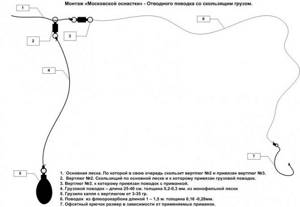
Repeating the underwater relief will make it possible to carry out a variant of wiring the equipment using the drawing method for special information.
Small background depths are among those places where fish are most common, and this, of course, indicates that the distance between the fish and the fisherman will be significant.
Fishing for perch with a retractable leash
Place and time of fishing:
To catch perch, choose places with standing water or weak currents near grass. Promising places will be near deep holes, the middle of sharp coastal slopes, and placers of shell rock.
Equipment:
To catch this predator, the thinnest equipment is used:
- Light or ultralight spinning rod 2.4 meters long
- Spinning reel size 1500-2000
- Monofilament line Ø 0.2-0.22 mm or braided cord Ø 0.1-0.13 mm.
- Sinker weighing from 10-12 g. up to 18-20 gr.
- Monoline leashes of equipment Ø 0.14-0.18 mm.
Lures:
Small twisters, vibrotails, slugs
Perch’s preferred colors are yellow, lemon yellow, and “machine oil” color.
Since they catch perch in places with a lot of grass, it is better to place the bait on an offset hook
Wiring:
If the perch is active, use a short step-by-step retrieve with a small twitch of the bait with the tip of the rod during the retrieve.
Catching pike perch on a retractable leash
Place and time of fishing:
Pike-perch is caught in deep river-bed holes with a hard, rocky, clay bottom; at dusk and sunset it’s good to catch fanged on the shallows bordering them
Equipment:
For pike perch, unlike perch, spinning rods with large dough are used - from 15 to 30 grams. The length is chosen depending on the required casting distance - but usually the golden mean is 2.4 meter blanks
If bites from a trophy predator are possible, the reel is larger than for perch - size 3000. Most often, a rigid and inextensible braided cord Ø 0.13-0.16 mm is wound onto the spool.
The line for mounting the diverter leash itself should be thicker than in the perch version - Ø 0.18-0.22 mm.
Sinkers are used weighing from 12 to 30 grams. – depending on the depth, fishing distance, current strength
Lures:
Medium-sized (5-7 cm) twisters, vibrotails, foam fish.
The color of such baits should be yellow, golden or greenish
Wiring:
When catching pike perch on a retractable leash, a classic stepped retrieve is used. If the bite is weak or the grip is uncertain, the wiring is made slower, the number of turns is reduced from 3 to 2 or even 1.
Fishing technique with Moscow rig
Moscow equipment is used in places where traditional jig gives poor results. These could be sharp edges that the jig bait simply flies past, local anomalies, and the like.
The rate of fishing with Moscow equipment is very slow, which denies the possibility of using it as a search engine. At the same time, it is with it that it becomes possible to fish literally every centimeter in the selected area.
This is also facilitated by a certain independence of the behavior of the equipment from the weight of the load. If in a jig or some other spaced equipment the weight of the load is selected with strict reference to the fishing conditions (depth, current, wind, fish activity), then in a retractable leash we have the opportunity to choose the load that is convenient for us. For example, if in a certain place weights of 10-12 grams are used for jig fishing, then you can put one and a half to two times more weight on the Moscow equipment.
Thus, the casting range will increase significantly and the equipment will not be carried away by the current, if there is one. Despite this, the Moscow rig is in no way a replacement for the jig, but serves as a complement.
The wiring of the Moscow rig can be very different, depending on the type of bait and the fish that is intended to be caught.
- Actively playing baits allow slow, even retrieve. However, it wouldn’t hurt to add some variety to it: pauses and swaying the tip of the spinning rod.
- Passive baits, especially slugs and worms, require jerking. Their wiring is somewhat reminiscent of light twitching. But in this case, it is worth paying attention to the strength and frequency of jerks - the bait should move from side to side smoothly, without sudden movements. This approach is most justified in cases where the fish for some reason is in an inhibited state.
However, there are situations when sharp jerks can save you. Cancers and creatures also require animation, but in their case it all depends on the degree of passivity. This means that the more passive the bait, the more active the animation should be. In this case, it appears in the form of short and fairly frequent, but light, jerks.
Catching pike on a retractable leash
Place and time of fishing:
Backwaters and thickets of aquatic vegetation, areas of open water bordering such places, trees and snags lying in the water, deep holes and dumps in them.
Equipment:
For pike, which are caught much less often than pike perch and perch when fishing on a diverter leash, pike perch equipment is used - a fairly powerful spinning rod, strong braided fishing line, and a reel of size 3000 or more.
Lures:
Large brightly colored twisters, vibrotails, worms ranging in size from 8 to 10 cm. Unlike other predators, pike reacts well to combinations of white and red, green and red colors of the baits used.
Wiring:
Standard stepped wiring with elements of small and sharp twitching
Bait selection criteria
One of the important aspects that ensures effective fishing is the choice of bait.
Twisters
For the most part, anglers who choose a retractable leash prefer to use twisters as bait for spinning rods.
Thanks to this, it is possible to choose bait from a wide range of colors and shades, to suit every taste and size, and also use bait based on weather conditions, fishing depth and fish activity. The undoubted advantage of twisters is their naturalness in water, which is identical to live fish. And also lightness, which allows the bait to smoothly reach the bottom, unlike other analogue options.
Vibrotails
Vibrating tails are quite relevant when fishing with bottom equipment, for example, when “hunting” for gobies or rotans, as well as when catching ruff. The dimensions of such bait are selected in accordance with the intended catch.
Spoon
Various spinners are used for a withdrawal leash much less often than the baits described above, due to the need to use a fairly heavy weight. Indeed, during one of the leash retrieves, the fisherman must accurately feel the movement of the equipment through the water and under it. When choosing spoons and other similar baits, you need to be guided by the type of fish; for example, for perch it is better to choose bright, shiny options.
Wobblers
A good, but not the most common option are wobblers and various floating suspenders, which are quite similar to twisters, especially during the wiring period. However, wobblers are not recommended for deep-sea fishing; they are best used in shallow water.
The best fishing practices when fishing with a retractable leash
Dragging along the bottom
This wiring works very well for a passive predator.
It is performed as follows:
- After casting the bait and reeling out the slack of the cord or line with the reel, wait until first the sinker and then the bait fall to the bottom
- The tip of the rod is lowered as close to the water as possible
- Retrieving is done by slowly winding the cord - the bait rises low above the bottom soil, and the sinker of the rig drags along it, raising trails of turbidity that attract fish
The predator grabs the bait during a pause or slowdown in the retrieve
Dotted line animation
This wiring is a type of drawing. The difference from the latter is that while the bait is moving in the bottom layer, the angler twitches the tip of the rod during pauses.
Aggressive jerking retrieve
This type of bait animation consists of the following techniques performed sequentially:
- After casting and dropping the sinker to the bottom, a short jerk is made, which sets the entire equipment in motion;
- Then the cord is wound at different speeds, accompanying each revolution of the spool with a jerk;
- If there are no bites, they pause, allowing the sinker to fall to the bottom;
- The series of jerks is resumed by changing the speed of the drive;
Trolling Secrets
A retractable leash is also used when trolling.
In trolling fishing, heavier weights weighing 40 grams or more and baits with a length of 15 cm are most often used. Of the baits in such equipment, special trolling wobblers are most often used, less often - silicone baits.
Feasibility of application
In what cases is a diverter leash used, and what are its advantages and disadvantages? Let's try to figure it out point by point.
- The Moscow rig allows you to cast a light bait over a long distance. It all depends on the weight of the load. Moreover, the sinker does not in any way affect the play of the wobbler or twister, since it is located at a distance from it.
- The retractable leash allows you to fish with the lightest baits using a more powerful rod. It is enough to choose the appropriate mass.
- When using this montage, it becomes possible to animate the bait at one point, similar to a drop shot. This works especially well on river flows. Having thrown the rig to the selected point, twitching the tip of the whip can make the silicone or wobbler dance in place.
- The lack of weight on the bait makes it play more relaxed and at ease, in contrast to the combined installation.
- A retractable leash allows you to feel the bottom structure better than a conventional jig rig.
The Moscow equipment also has some disadvantages, which are better called contraindications for use.
- In particularly strong places, the use of equipment is severely limited. Here you can only fish with non-snagging baits like silicone on an offset hook.
- The use of installation on muddy bottoms is also limited. Due to the soft cover, the sensitivity of the equipment tends to zero when fishing, which violates the very principle of the fishing method.
Conclusion! A clean, hard bottom is the best choice for using a diverter leader.
Winter use
In winter, a diversion leash is used not only on ice-free rivers, diversion channels of thermal power plants, but also for ice fishing.
Winter equipment with a branch leash is assembled like this:
- A large jig, a heavy spoon or just a sinker is tied to the end of the fishing line used for vertical trolling.
- A loop is made 30-40 cm above, to which a short (up to 10-15 cm) leash with a hook and a small bright-colored twister or a bunch of large worm is tied
The fishing technique is similar to trolling - swings of the fishing rod alternate with pauses of varying durations.
Wiring Techniques Overview
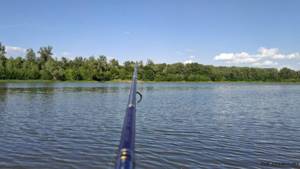
Fishing technique with a retractable leash
Usually, when fishing with a spinning rod, great importance is attached to wiring. But in the case of catching perch with a diverter, the main factor in successful fishing is search. If a perch can be found, it takes the simplest, even retrieve.
After casting and the load falling to the bottom, a smooth, slow reeling begins (turning the reel in 2-3 seconds).
It is with a uniform retrieve that it is recommended to begin mastering fishing with a retractable leash.
Experienced fishermen combine fishing in a variety of ways - a combination of short jerks with reeling and pauses. Perch often takes even a bait lying motionless on the bottom, sucking it in, as a peaceful fish does.
Pike and pike perch are rarely caught on a retractable leash purposefully. Most often they are caught in the bycatch of perch. But if a large predator takes the lead, you should pay more attention to the retrieve: play with the speed, duration of pauses, etc.
If the perch is hunting for fry and making pots, but is not caught in the cut-off with a diverting leash, it is worth trying to change the equipment to a surface one. Read: non-standard equipment for catching perch
To animate the bait, three types of techniques with a retractable leash can be used:
- Line-dot animation. It provides a big catch. The technique is characterized by moving the bait along the bottom, alternating with stops to play with the bait.
- Driving along the bottom. It is characterized by a slow move and the use of spot fishing in small creeks. The technique is performed by immersing the equipment to the bottom and then dragging it along the ground, using a fishing line.
- Wiring with aggressive jerks. The technique is used to catch active predators and is similar to twitching. Periodically, the rod makes sharp jerks with long pauses. When you stop, the weakened fishing line is reeled in.
In order for fishing to be as effective as possible, you must adhere to certain requirements:
- It is recommended to perform a sliding installation in order to eliminate as much as possible tangling of the line and twisting of the leash;
- Cast and retrieve along the current line, best at an angle of 70 degrees;
- Use various casting “tricks” and “tricks” only as needed based on each specific conditions.
Diversion equipment is characterized by a number of advantages and disadvantages:
- The ability to use slower retrieves with pauses and play of the bait.
- Long casting is very effective.
- Possibility to use small baits and heavy weights.
- The load from heavy weights is completely eliminated.
- It is important to use edible rubber when fishing, especially for small fish.
- A well-chosen bait allows you to catch even inactive fish.
- Free swivels allow the bait to move in all directions.
- Wiring with such equipment allows you to tap the bottom well.
Flaws:
- Quite often there are situations in which leashes and fishing lines get twisted and overlapped;
- A small spinning rod requires a lot of effort and experience when casting;
- Fairly slow fishing.
When using a retractable leash, the main thing is to wisely choose the bait and equipment that will best suit the weather conditions and the intended fish.
Source
